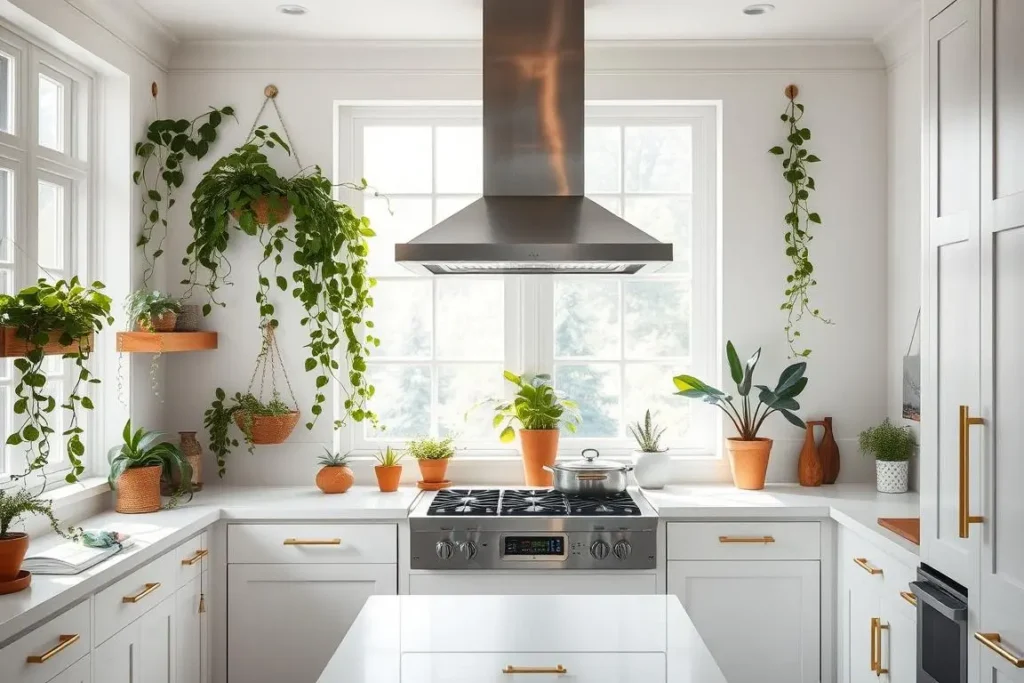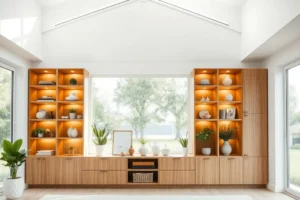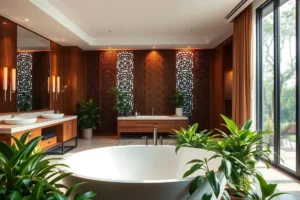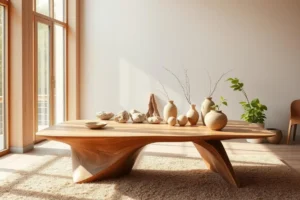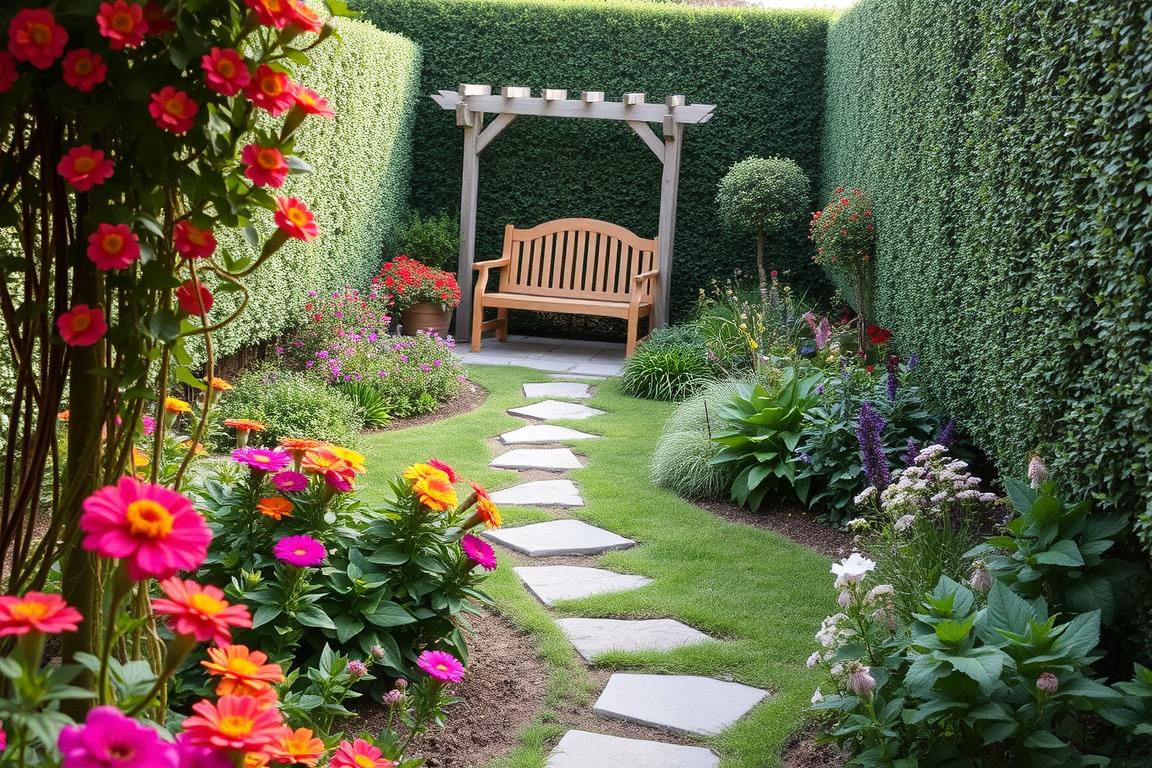Imagine stepping into a kitchen that’s full of warmth and light. It’s a place where every detail, from the countertops to the sunlight, connects you to nature. Your kitchen is more than just a room; it’s where memories are made and life unfolds.
These game-changing ideas will make your kitchen a nourishing space for your family and the planet. It’s a place where life happens.
Whether you’re renovating or updating, natural design can turn your kitchen into a harmonious hub. By using organic materials, smart layouts, and eco-friendly choices, you’ll increase your home’s value. You’ll also create a space that feels like an extension of the outdoors.
This guide shares 11 proven secrets for a complete kitchen transformation. It’s both functional and beautiful.
Table of Contents
ToggleKey Takeaways
- Natural design secrets enhance both beauty and functionality in kitchen spaces.
- Prioritizing natural light and organic materials improves wellbeing and home value.
- Game-changing kitchen ideas focus on sustainability without sacrificing style.
- Integrating plants and earthy tones creates a calming, inviting atmosphere.
- These strategies make kitchens more functional for daily life while connecting to nature.
1. The Power of Natural Light in Kitchen Design
Maximizing natural light is key in kitchen renovation tips that make your space look better and work better. Let’s see how sunlight can make your kitchen brighter and more welcoming. It also fits well with organic home improvement ideas.
Importance of Windows
Big windows or skylights bring sunlight into your kitchen, cutting down on the need for artificial lights. South-facing windows catch morning light, while north-facing ones give soft, even light. Think about swapping old windows for new, energy-saving ones to keep warm in winter and cool in summer.
Skylights: A Bright Idea
Skylights make small kitchens feel bigger right away. Tubular designs collect daylight even in tight spaces, and vaulted styles add height. Choose Energy Star-rated skylights for better light and temperature control. Many now open for ventilation, combining looks and function.
Choosing Light-Filtering Treatments
Use these to control glare and keep things private without losing light:
- Sheer cellular shades that soften harsh light
- Wooden blinds with slats for adjustable coverage
- Smart electrochromic glass that darkens with touch controls
Match these treatments with light-colored countertops and cabinets. This way, you reflect and enhance daylight naturally.
2. Embracing Organic Materials
Choosing the right materials is key to a sustainable kitchen design. Options like wood and stone are good for the planet and look great. They’re a smart start for an environmentally-conscious kitchen remodel.
Hardwood vs. Engineered Wood
| Feature | Hardwood | Engineered Wood |
|---|---|---|
| Durability | Long lifespan | Wears evenly |
| Moisture Resistance | Species-dependent | Laminated layers reduce swelling |
| Sustainability | FSC-certified sources | Less waste in manufacturing |
| Cost | Higher initial price | Better budget option |
Recycled Natural Stone
- Recycled granite: Durable countertops with pre-existing patina
- Salvaged marble: Unique patterns from reclaimed sources
- Post-consumer quartz: Engineered stone made from 30% recycled content
Sustainable Cabinet Options
Choose from:
- FSC-certified oak or maple
- Bamboo (fast-growing, biodegradable)
- Reclaimed barnwood or antique timbers
Opt for finishes with low-VOC sealants to cut emissions.
3. Color Schemes Inspired by Nature
Nature’s colors are perfect for Transforming kitchens naturally. You can choose from soft tones or bright colors. These choices make your kitchen feel like the outdoors. Let’s see how to bring nature into your kitchen.
Earth Tones and Their Benefits
Begin with colors from nature. Natural design secrets show that terracotta, moss green, or driftwood gray are great. These colors make your kitchen feel welcoming and fit any size.
| Color | Example | Impact |
|---|---|---|
| Earthy Beige | Behr’s “Warm Linen” | Expands small kitchens visually |
| Sage Green | Benjamin Moore’s “Mistaken for Mint” | Calms high-traffic areas |
Adding Pops of Color
- Use coral for warmth (think sunsets)
- Try sky blue for coastal vibes
- Incorporate gold accents for metallic earth tones
Harmonizing with Natural Elements
Match your kitchen colors with the rest of your home. Here’s how:
- Match wood tones to countertops
- Choose backsplash tiles mirroring nearby walls
- Test hues under your kitchen’s actual light
4. Incorporating Indoor Plants
Adding greenery to your kitchen brings life and freshness. Green kitchen upgrades like indoor plants improve air quality. They also create a calming atmosphere. An Eco-friendly kitchen makeover thrives with low-maintenance plants perfect for busy lifestyles. Start with these easy-to-care-for options.
Best Low-Maintenance Kitchen Plants
| Plant | Light Needs | Watering | Benefits |
|---|---|---|---|
| Snake Plant | Indirect light | Every 2-3 weeks | Purifies air, thrives in low light |
| Pothos | Bright indirect light | Let soil dry between waterings | Trails beautifully in hanging pots |
| ZZ Plant | Low to moderate light | Once a month | Resilient to neglect |
Benefits of Herbs in Cooking
Grow fresh herbs like basil, thyme, and rosemary in small pots or Eco-friendly kitchen makeover planters. Use these tips:
- Place near windows for sunlight
- Trim regularly to encourage growth
- Use recycled pots for sustainability
Creating a Green Corner
Design a focal point with a mix of plants. Combine hanging vines, small shrubs, and potted herbs. Ensure the area has consistent light and drainage. A green kitchen upgrades corner can include:
“Plants make spaces feel alive.” — Urban Green Design Studio
Pair plants with natural materials like ceramic pots or stone plant stands for cohesion.
5. Open & Flowing Spaces
Starting a Complete Kitchen Transformation means making it feel big. Open layouts bring in more light and connect spaces. These Kitchen renovation tips help you clear out clutter and improve flow.
Removing Barriers: Open Shelving
Replace closed cabinets with open shelves for a lighter look.
- Choose glass or wire frames for an airy feel
- Organize items by height and color for a neat display
- Match with simple backsplashes for clean lines
The Role of Kitchen Islands
Islands are key for cooking and socializing. Pick one that fits your kitchen:
| Type | Best For | Space Required |
|---|---|---|
| Prep Island | Small kitchens | 3ft x 5ft minimum |
| Seating Island | Dining areas | 4ft x 8ft ideal |
| Double-Ended | Large layouts | 6ft+ width |
Traffic Flow: Navigating Your Kitchen
Improve movement with these tips:
- Identify busy areas near sinks and ovens
- Ensure 42″ space between counters for easy movement
- Use pull-out drawers under islands to save space
By using these ideas, even small kitchens can feel open. Focus on clear paths and use vertical storage to make the most of every inch in your Complete Kitchen Transformation.
6. Eco-Friendly Appliances
Choosing eco-conscious appliances is essential for a Eco-friendly kitchen makeover. They use less energy, lower your bills, and support Green kitchen upgrades. Start by picking Energy Star-certified models. They use less power without losing performance.
Energy-Efficient Options
The LG LFXS28766S fridge uses 20% less energy each year thanks to its linear compressor. Bosch‘s induction cooktops heat up quicker, using less energy than gas or electric ranges. Whirlpool‘s ENERGY STAR dishwashers use 30% less water than older models.
Water-Saving Innovations
Try Delta Faucet‘s low-flow faucets, which use only 1.5 gallons per minute. The Frigidaire FG1000BTS dishwasher has soil sensors. They adjust wash cycles to save water and energy.
Smart Tech for Sustainability
Smart thermostats for fridges let you control temps from your phone. GE Profile‘s Wi-Fi ovens cook more efficiently, using less standby power. The EPA says smart appliances can cut energy use by up to 25%.
Need to replace old appliances? Donate working ones to Habitat for Humanity or recycle them. Each upgrade brings your kitchen closer to being fully sustainable.
7. Textures for a Natural Feel
Discover natural design secrets by mixing textures that feel like the outdoors. Every surface, from countertops to cabinets, tells a story. These organic home improvement tricks make textures into art.
Mixing Materials: Metal and Wood
- Pair brushed nickel hardware with reclaimed oak for rustic elegance
- Combine copper accents with bamboo cabinetry for warmth
- Use stone tiles against smooth marble backsplashes for contrast
Fabrics That Enhance Comfort
| Fabric | Benefits | Care Tips |
|---|---|---|
| Linen | Airflow & moisture resistance | Machine wash cold |
| Cotton | Durable for upholstery | Spot clean spills |
| Performance Fabrics | Stain resistance for high-traffic areas | Spot clean with mild detergent |
The Importance of Finishes
Matte finishes on cabinets reduce glare and highlight wood grain. Hammered textures on metal add depth without reflecting light. Pick finishes that let materials “breathe” for an organic feel.
8. Sustainable Flooring Choices
Choosing the right flooring is essential for a sustainable kitchen design. It must be durable and eco-friendly. Your choice affects both the kitchen’s life and the environment. Look for materials that support an environmentally-conscious kitchen remodel.
- Fast-growing bamboo is as hard as oak but make sure it’s made without formaldehyde.
- Moisture-resistant options are best for humid kitchens, but solid bamboo needs sealing to avoid warping.
- Prices start at $4-$8 per sq. ft., with strand-woven bamboo being the most durable.
Cork Flooring:
- Natural cork reduces noise and fatigue, perfect for kitchens.
- Recycled cork tiles use waste and keep insulation properties.
- Use non-toxic finishes to prevent stains; great for humid areas.
Tile vs. Hardwood:
- Tile: Porcelain or recycled glass resist moisture but need underlayment for sound.
- Hardwood: Choose FSC-certified woods like reclaimed hickory. Use moisture barriers in busy areas.
- Look for FloorScore certifications for low-emission adhesives in both.
Every flooring choice affects your kitchen’s health and the planet. Focus on certifications like Greenguard for VOC limits and lifecycle assessments. This ensures your choices are long-lasting and ethical.
9. Clever Storage Solutions
Maximizing storage without losing style is essential for smart kitchen design. Game-changing kitchen ideas often involve rethinking storage. These kitchen renovation tips transform unused areas into useful spaces, keeping your kitchen tidy and welcoming.
- Install tall cabinets to the ceiling, adding shelves for rarely used items.
- Hang pots, utensils, or racks on magnetic strips or wall-mounted systems.
- Use over-door organizers to free up counter space.
Hidden Compartments for Clean Lines
Blend function with form using these discreet options:
| Type | Example | Best For |
|---|---|---|
| Toe-Kick Drawers | Storage beneath base cabinets | Small items like spices or utensils |
| Appliance Garages | Enclosed spaces for blenders or slow cookers | Kitchens with limited counter space |
Multifunctional Furniture
Adapt to your needs with pieces that serve double duty:
- Expandable islands with built-in seating or storage.
- Nesting tables that stack when not in use.
- Bench seating with hidden compartments for pantry items.
Begin by understanding your habits. What items do you use every day? Make those easy to reach. For smaller kitchens, use vertical and hidden storage. Larger kitchens benefit from pieces that do more than one thing. These strategies make your kitchen a functional haven without clutter.
10. Balancing Aesthetics and Functionality
Creating a kitchen that looks good and works well starts with knowing how you use it. Focus on layouts and materials that fit your daily life but also keep the natural look you want. Every choice, from storage to countertops, should be both beautiful and practical.
Designing for Daily Use
First, think about your daily routines. Where do you cook, entertain, or get things done? Choose materials like bamboo countertops or quartz that are tough but look natural. Open shelves and pull-out pantries help keep things tidy and easy to find.
Keeping It Attractive yet Practical
Natural textures like reclaimed wood or cork add beauty and last long. For example, a farmhouse sink with green appliances looks good and saves energy. Adding modern touches like charging stations or under-cabinet lights keeps things functional without losing the natural feel.
Creating a Family-Friendly Environment
Set up different areas for different activities. Have a prep zone near windows, a homework spot with comfy chairs, and a place to charge devices. Use adjustable shelving and rounded edges on cabinets for safety. Choosing timeless materials like marble or slate ensures your kitchen stays stylish over time.
A balanced kitchen combines nature’s beauty with your family’s needs. By focusing on these key points, you’ll make a space that’s more than just a room. It’s a living, evolving hub that follows organic home improvement principles.
FAQ
What are some effective kitchen renovation tips for a natural design transformation?
To get a natural kitchen look, start with lots of natural light. Use organic materials and add indoor plants. Eco-friendly appliances and sustainable flooring are also key. Each choice helps make your kitchen green and beautiful.
How can I embrace organic materials in my kitchen renovation?
Choose organic materials like solid hardwood and recycled stone. Look for FSC-certified woods and finishes that are good for the air. These choices make your kitchen look great and help the planet.
What are some eco-friendly kitchen makeover ideas?
Make your kitchen green by using energy-saving appliances and water-saving tech. Choose materials like bamboo and cork for floors. Smart storage and vertical space use make your kitchen better for the planet and you.
How can I create a family-friendly kitchen environment?
Make your kitchen safe and fun for all ages. Use materials that are easy to clean and won’t get damaged. Set up different areas for cooking, homework, and hanging out. This way, everyone can enjoy the kitchen.
What are some natural design secrets for a kitchen that enhances wellbeing?
For a kitchen that feels good, use calming colors and lots of plants. Good air and natural light are also important. These elements make your kitchen a cozy place to relax.
Can you suggest some game-changing kitchen ideas?
Try open shelving for a more open feel. Use furniture that does more than one thing. Skylights bring in more natural light. These ideas make your kitchen bigger, more welcoming, and eco-friendly.
What are the benefits of incorporating indoor plants in my kitchen?
Indoor plants improve air quality and look great. They also let you grow your own herbs. Pick easy-to-care-for plants for a kitchen that’s both beautiful and low-maintenance.
How do I choose the right sustainable flooring for my kitchen?
Look at options like bamboo and cork for flooring. Think about how durable and easy to clean they are. Make sure they’re certified as eco-friendly to be sure they’re good for the planet.
What should I keep in mind for lighting options in my natural kitchen design?
Use natural light by placing windows and skylights right. Add warm, adjustable lights for evening. Light treatments help control brightness and keep things private.
How can I balance aesthetics and functionality in my kitchen renovation?
Choose materials that are both beautiful and strong. Plan your layout for easy use. Make sure your kitchen is pretty and practical for everyday life.

